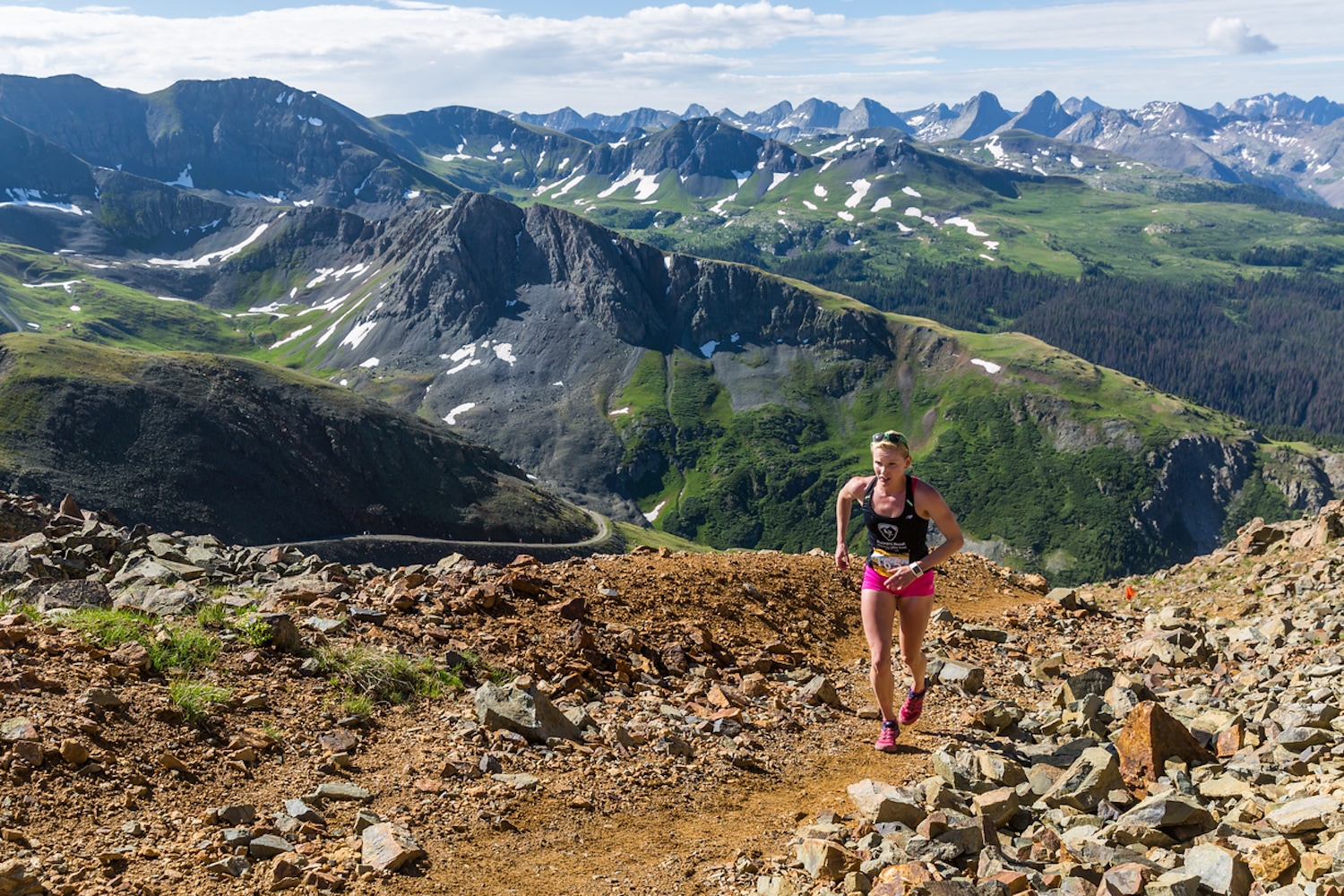Expert dietitians, coaches and athletes on how to hone and keep a positive body image
Colorado-based trail runner Taylor Nowlin was a track and cross-country runner from middle school through college. Ryan Good, a trail runner based in Portland, Oregon, was a military veteran turned road runner. Nowlin and Good both started trail running in 2015, and run mountain ultra trail races around the country. Aside from joining the trail running community at the same time, another common thread of these life-long athletes—despite their diverse backgrounds, not knowing one another, and a 20-year age gap—is that they have both struggled with negative body image issues.
Distorted body image—an unrealistic view of how someone sees their body—can happen to anyone (including trail and ultrarunners) and for a variety of reasons. When an athlete faces negative body perception, that internal relationship can escalate into disordered or obsessive eating habits which can lead to physical injuries, energy deficit, mental exhaustion, lack of self-esteem, disrupted menstrual cycles, low bone density, unhappiness with performance or even depression.
“It’s exciting to see the research evolve, but it’s sad that this issue breaches all human differences and there are no barriers.”
Little research exists that specifically looks at body image or disordered eating within trail and ultrarunning. Often, the two sports are clumped into studies pertaining to marathons and road running or endurance athletes in general. In the last 5 to 10 years, more sport-specific studies have begun to pop up, explained Katie Kage, Assistant Professor in Nutrition and Dietetics at the University of Northern Colorado. Kage is a Registered Dietitian, Certified Exercise Physiologist, and has researched body image and disordered eating prevention for a decade.
“It’s exciting to see the research evolve, but it’s sad that this issue [of body image and disordered eating] breaches all human differences and there are no barriers,” said Kage. “It used to be viewed by society as a Caucasian, female, upper-class’ issue. Now, research is showing that’s not true: Historically, the data hasn’t been studied to look at sex differences, social economic differences and ethnic differences.” Furthermore, she said, it’s difficult to study the problem among men because they tend to be less forthcoming than women with reported data.
“As athletes’ bodies change, they can feel even more pressure or a sense of shame or guilt, because they did fit that ideal.”
Here’s the catch-22: Trail and endurance running increase endorphins and often lead to healthy weight management, which increases body image positivity. However, at times, it can be difficult for athletes to accept the body’s changes during the off-season, following an injury or pregnancy, after retirement or due to aging. “Athletes’ bodies tend to fit the Western societal norm of what an ideal body looks like. They often have a positive body image, because that’s what everyone is told they should attain. Then, as their body changes, they can feel even more pressure or a sense of shame or guilt, because they did fit that ideal,” said Kage.
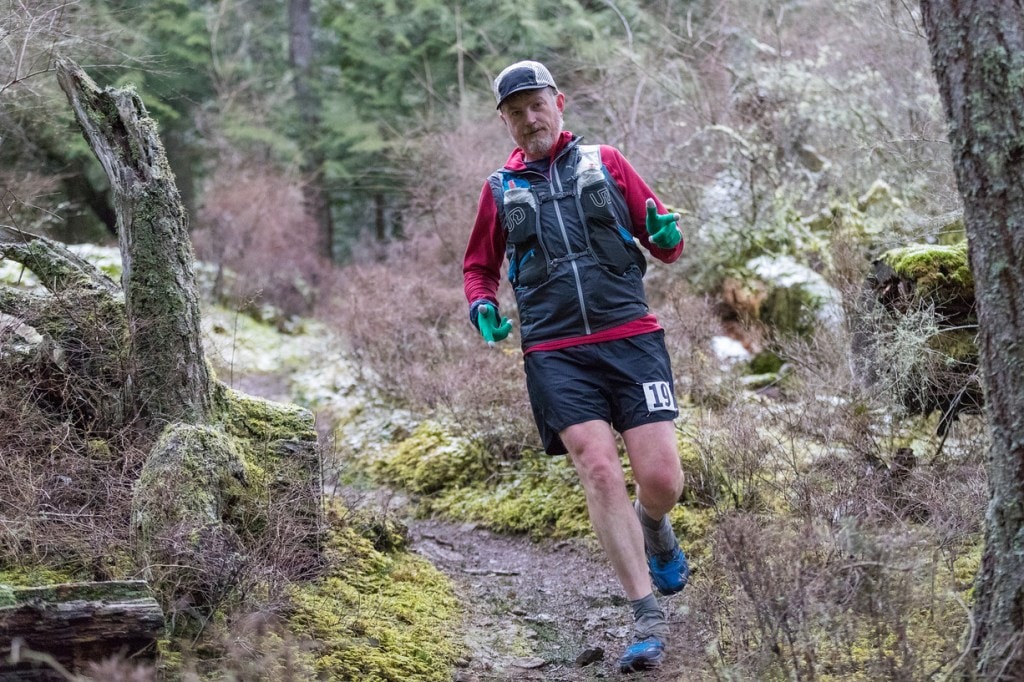
Ryan Good runs the 2017 Orcas Island 100 mile race, his debut century-distance event. His first thought when he saw the photo was that he was self-consciousness about his “gut.” Photo courtesy of Good
Good was a road runner in his twenties. Following marriage, kids, his career growth and the loss of family and friends, he realized time was of the essence so he jumped into a dream he’d always had: to run ultramarathons. Now, Good has run 50Ks and 50-milers, and he completed the Orcas Island 100 miler in February 2017—all injury-free and within a healthy body weight. All the while, he’s always felt self-conscious about his body appearance and reaching an ideal body weight for performance.
When he saw the finish-line photo of his first 100-mile race, he was consumed by the perception that he looked fat.
“I hope that people open up and don’t suffer alone. In our society, men aren’t socialized to be open about emotions and our failures. We’re socialized to be public about our successes and strengths. I feel guilty talking about it because this seems to be a bigger struggle for the women in my life. I don’t think men have the same pressure as women, but it’s still there. There’s an ideal that’s presented,” said Good, who explained that he has always been stuck in a dichotomy between high fitness and body insecurities.
During Good’s years in the military, excellent fitness was the norm yet he believed he was out of shape. He internalized the ideology that superior fitness equated to self-discipline and that anything less than perfect was a sign of laziness. Later, in his mid-twenties, when Good ran road marathons, he weighed 160 pounds with 11 percent body fat, at 6 feet tall, and “still had this weird image that I wasn’t good enough,” Good said. “Now I’m 180 pounds. I sometimes think that if I could get down to 160 pounds, I’d be so happy with my body. Then I remember, I had the same frustrations when I was that weight. I’m consciously aware of this problem. I think it will always be a mental game that I have with myself.”
Men tend to be at a lower risk for disordered eating or negative body image than women, but the issue can still exist.
Based on the premise that men naturally have less body fat than women, men tend to be at a lower risk for disordered eating or negative body image than women, but the issue still exists for both, explained Nancy Clark, an internationally acclaimed, board-certified sports dietitian (CSSD), registered dietician (RD), sports nutritionist, and weight coach for a variety of athletes including ultrarunners and marathoners. One recent study of male long-distance runners found that high volumes of aerobic exercise can be linked to reduced testosterone levels—called EHMC (exercise-hypogonadal male condition)—which can likewise be exacerbated by inadequate nutrition, according to the July 2017 issue of The European Journal of Applied Physiology.
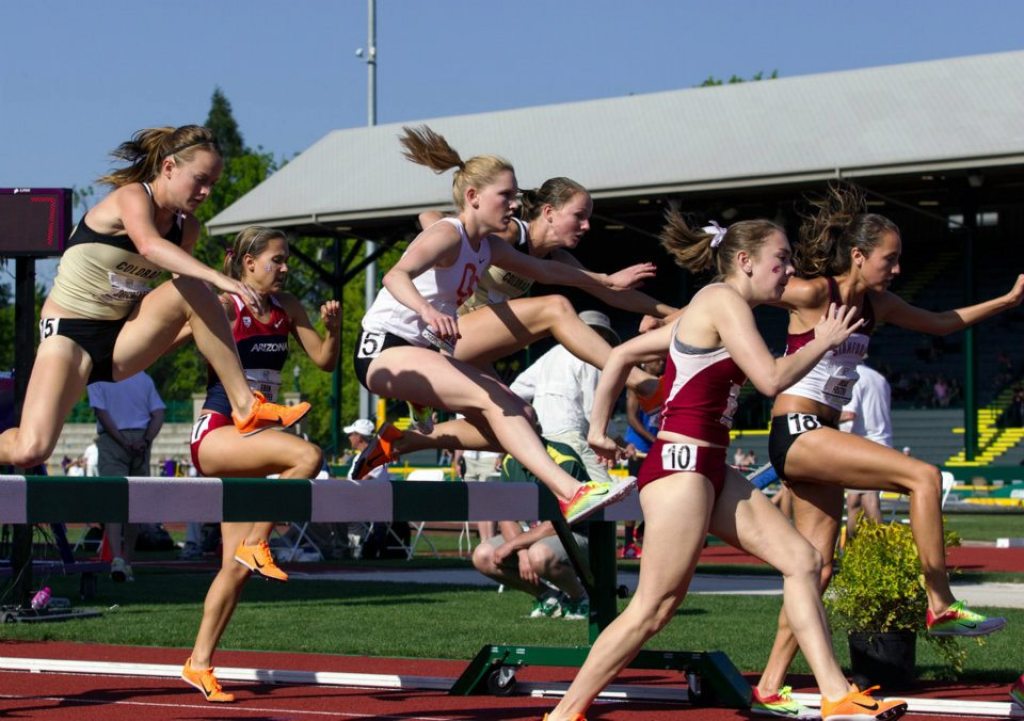
Collegiate track runner Taylor Nowlin racing the steeplechase at Howard Field at the University of Oregon, in 2011. Photo courtesy of Nowlin
Nowlin, 26, has been a runner for more than half her life. She started with track and cross-country in the 7th grade, and in college, she became a steeplechaser. Following graduation, she trained for Olympic marathon trials qualifiers. When she wasn’t fulfilled by the experience, she switched to mountain, ultra and trail races. Now, Nowlin views food as fuel—rather than as an enemy—and her body as a machine that allows her to reach the top of a peak or the end of a technical race. In trail running, she feels mental positivity and pride for her accomplishments, but it’s been a long road. For years she struggled against hyper self-criticism, disordered eating, and the incurred stress fractures. “There’s so much enjoyment that you can get from food, and I missed out on that for such a long time. I was too self-critical, and I couldn’t be happy even though I was doing amazing things,” said Nowlin.
Nowlin was one of the fastest girls on the high school track team and her self-worth became entangled with her athletic performance. During her sophomore year, her times slowed down and she began to restrict her eating by throwing away her lunch or returning food when she got home. “I gained weight because I was going through puberty—which was completely normal—and in my mind, I erroneously attributed the weight that I gained to my performance,” said Nowlin.
Her body’s undernourishment led to stress fractures that stretched into her freshman year of college, and then the program’s effort to teach the team about healthy nutrition was at times counteracted by a culture of restrictive eating habits such as girls bringing their own food to restaurants or ordering dressing on the side of a salad.
“I watched teammates lose weight really quickly, set PRs and get a lot of attention from the team and coaches.”
A recent study of collegiate female athletes with bone stress injuries (BSIs) found that among 16 different sports, cross-country runners had the highest number of BSIs. Close to 50 percent of those female runners with sustained BSIs were at a moderate or high risk for the female athlete triad, according to the report published in The American Journal of Sports Medicine in December 2016. On a scale of low to high, the Female Athlete Triad Cumulative Risk Assessment score helps to identify if exercising women with an energy deficit are at a risk for the triad, a syndrome that includes disordered eating, menstrual disturbance and a decrease in bone mineral density. The challenge isn’t only faced by collegiate athletes. A Sports Medicine study of the 2014 Comrades Marathon—an 89-kilometer race in South Africa, the world’s largest and oldest ultramarathon race—found that 44 percent of female athletes were at risk for the triad.
“I think that we could have had a better team culture that was more supportive of each other and focused on nutrition as a tool to make us stronger and faster,” said Nowlin. “I watched teammates lose weight really quickly, set PRs, and get a lot of attention from the team and coaches. It was easy to see that weight loss was a cause for their results. One side of you wants to be sustainable and the other wants you to do whatever it takes. You only have four years to be a great athlete and NCAA eligible, which puts a lot of pressure on athletes perform in the moment rather than being a lifelong athlete.”
“Say, ‘Hey, I’m being extra critical of my body or comparing myself to other people. I don’t need to do that and I look awesome.’”
According to the book, Young Runners at the Top, dropping pounds is tempting for girls because they often watch elite runners and “focus on the thinnest athletes but ignore counterexamples and believe that they need to emulate this body type in order to be maximally successful.” Lower body mass does translate to a higher VO2 Max, which allows a higher level of oxygen utilization. However, a body that’s too lean can’t perform to its theoretical potential. And in trail and ultrarunning, muscles can play a huge role in powering up climbs or bombing descents.
“You always carry it with you as a battle that you’ve never truly won. It’s something that you have to realize about yourself and say, ‘Hey, I’m being extra critical of my body or comparing myself to other people. I don’t need to do that and I look awesome,’” said Nowlin.
What You Need to Know About Your Diet, Body and Mind
Here are facts and tips from expert dietitians, coaches and athletes in ultrarunning to help trail athletes maintain positive body perception, a healthy body culture and a fulfilling relationship with food.
Your Diet
The time for serious calorie cuts is not right before a race. “I ask my clients for their top three goals, and 90 percent of the people who come to me for an assessment have a running or performance related goal and also say that they’d like to lose weight. It’s a prevailing thought. They associate weight with performance (or contentment),” said running coach Kenzie Barlow. “They might be depriving their body of exactly what they need to hit that performance goal. I never encourage someone to try to drop weight while they’re training for a race.”
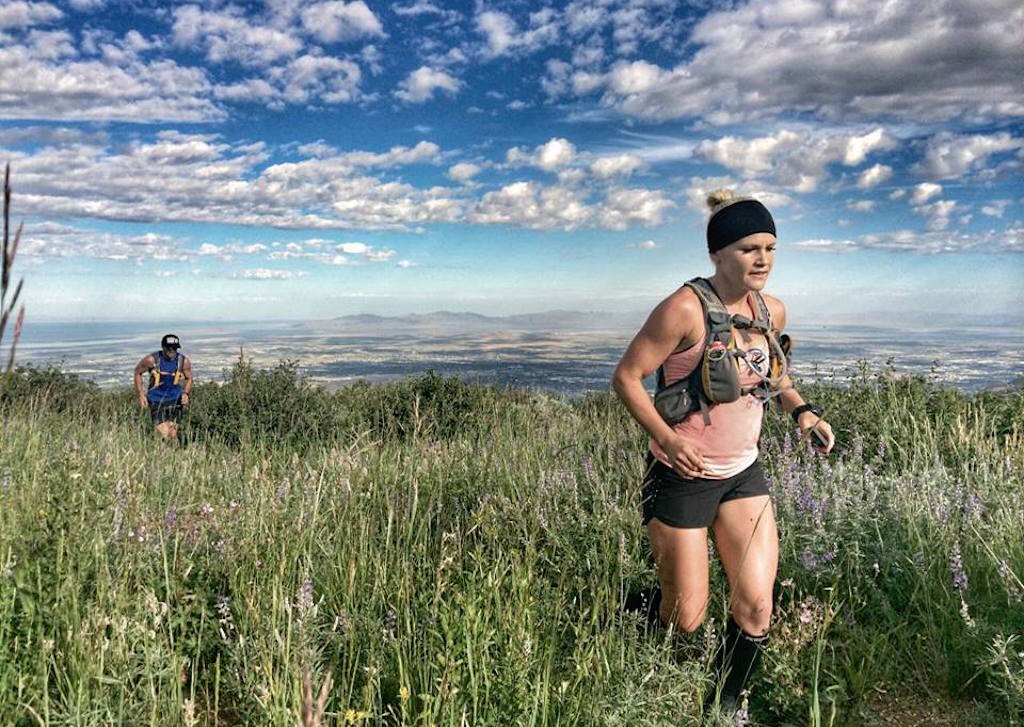
Kenzie Barlow on a 26-mile training run for the 2015 Bear 100-mile race. Photo courtesy of Barlow
Feeling cold? You may need to eat more. When someone is chilly, that can be a sign of under-fueling. “At the start of a race, if there’s a person wearing a singlet and shorts and another person is bundled up, I think the latter must be under eating. When people fuel their body better, they’re warmer,” said Clark.
Craving dessert? You could be hungry. “A lot of people with a wicked sweet tooth think that it’s genetic, but the fact is that people crave sweets when they are hungry. When you’re hungry, you want quick energy,” said Clark.
Be flexible with your diet. Consuming a variety of foods adds power to performance and resilience for health. “The day should be divided into ‘food buckets’ every four hours—with an amount of calories that’s based off of an individual’s energy needs—which includes protein to build and repair muscles, a grain to fuel muscles, fruit or vegetables for vitamins and minerals, and dairy or calcium-rich food for bones. A bagel is not a balanced sports diet. A bagel plus peanut butter and banana and yogurt is—that’s not too much food,” explained Clark, who offers more day-to-day tips in her book, Food Guide for Marathoners: Tips for Everyday Champions.
Eat food you love with people you love. “Food is meant to be enjoyed. Runners need to make sure they fit in foods that taste good and that they get excited about eating. There shouldn’t be any food that an athlete restricts unless they have a medical diagnosis like gluten for someone who is a diagnosed celiac. And sharing that experience of eating food with other individuals will make sure they have a healthy food relationship,” said Kage.
Stumped? Look into blood diagnostics. “The biggest mistake I’ve made is not eating enough to sustain the amount of work that my body is doing, and not because I was intentionally trying to cut calories but because I wasn’t aware of how much I needed to eat,” said certified personal trainer Crystal Seaver, who has done meal prepping for most of her ultrarunning career. “I felt really tired all of the time, so I collaborated with a company called InsideTracker, which tracks your blood using different biomarkers. I found out that my iron levels were high but the binding capability was not working, so I was able to strategically change my nutrition and training.”
Seek professional help. If you need or want to lose weight, or if you want to improve your energy efficiency (what you need to eat in order to get the best performance), work with a registered dietician in addition to your coach and personal trainer, suggested Clark. More than 7,000 registered dieticians exist across the country, which you can find via https://www.scandpg.org.
Your Body
Remember that genetics play a major role. “It’d be nice if we had medical tests for this, but remember, the apple doesn’t fall too far from the tree. If you’re trying to be leaner and leaner and your weight isn’t budging, you may have reached your genetic weight. Consider your mom and dad and who you take after. The cost when you continue to consume less and less food is that you’ll feel more tired, [your metabolism can] end up in hibernation mode, or binge eating at night,” said Clark.
All body types can achieve their goals. “If you compare the body types of the top tier performers [in trail running], there is a lot more variety [than in road marathons], which goes to show that body type doesn’t necessarily decide what type of athlete you’re going to be and whether you’ll be successful or not,” said Barlow. Case in point: Professional ultrarunner Zach Miller recalls when an incoming freshman joined his college track and cross-country team, the teammate thought Miller would be the slowest runner based off of how his body was built—which wasn’t the case at all. “I’ve always been 5 foot 6. I was 145 pounds in college. I’m 135 pounds and I’ve thinned out, but I’ve always had huge legs, muscular arms and a barrel chest. At an ultra startline, there are guys who look like me and guys who look far more like the stereotypical runner than I do. There are so many body types within mountain running,” said Miller.
More muscle means more weight, and that’s OK. “I actually gain more weight when I’m running then if I wasn’t running at all,” said Barlow. Seaver similarly gains weight from her training routine: “The only way to limit weight gain is to limit strength training, and I can’t take that out of my routine. It’s a fine line because that muscle is what allows me to climb efficiently and keeps the rest of my body healthy and intact, but a five-pound difference feels less efficient.”
Your Mind
Mental health is key to a healthy weight and body image. “You can’t have a healthy body without a healthy mind. Individuals need to take care of themselves emotionally and mentally, so maybe that means they reach out to a mental health professional, such as a therapist, psychologist, or psychiatrist,” said Kage.
Turn worry into focus. No matter how big the goal is, don’t forget your inspiration for entering the sport. “There is this perfectionism of wanting to get this stuff—training, diet, performance—right. Once you’re in the sport and you have this competitive thing going, are you then comparing yourself to others? ‘Do I look like the next best runner?’ There is not necessarily a direct relationship to size and who wins. Neurotic tendencies can become functional instead of paralyzing if we can learn how to focus with them,” said Lisa Dorfman, Licensed Nutritionist and Dietitian, and Board Certified and Licensed Professional Counselor.
Practice self-kindness. Remember to be as nice to yourself as you would be to a friend. “Everyone has something that they feel self-conscious about at some point. Around the midsection, I may think I carry more weight than others and see it when I look in the mirror, and a friend says, ‘you look incredibly thin and fit.’ We’re always judging ourselves more than anyone else,” said Miller.
Shift your mindset to one of appreciation instead of envy. “I’m 5 foot 1 and have a lot of muscle. For a long time, I felt self-conscious about not fitting the mold of what a runner ‘should’ look like with elongated muscles. It took a few years, but once I stopped chasing how I should look and instead looked at how I performed, I became grateful for my body’s ability to withstand the hard challenges that my heart was asking it to do. My mindset shifted to one of appreciation for my body,” said Barlow, who started running in her mid-twenties after she had kids and eventually switched from marathons to ultra trail races.
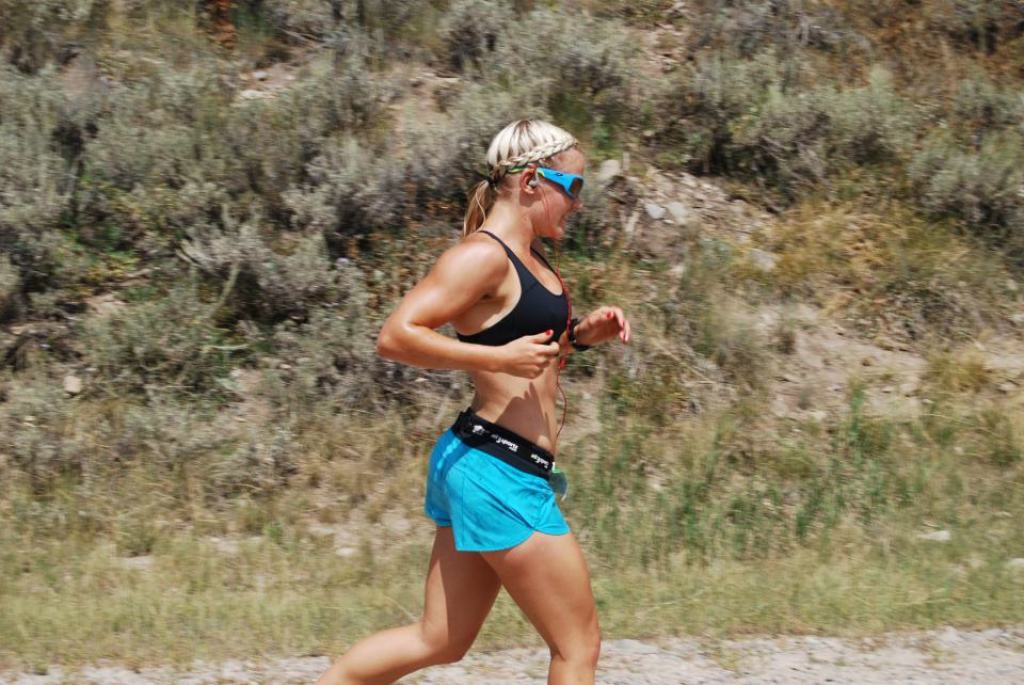
Kenzie Barlow racing the Epic Cache-Teton Relay Race in 2013, when she still ran all road races and did heavy weightlifting. Photo courtesy of Barlow
Bust stereotypes. Strive to be accepting of all body types. “People have to be very careful about accusations and speculation. Some runners have a build that is naturally very thin, and they are healthy and eating great amounts of food. They can get ripped to pieces on social media, saying that they must be anorexic or bulimic, which is equally harmful,” said Miller. “If I catch myself saying, ‘I don’t want to look like a runner—as in, someone who is super skinny,’ it’s a stereotype and is the same as someone else saying, ‘you’re not built like a runner, because you’re too muscular,’” said Seaver.
